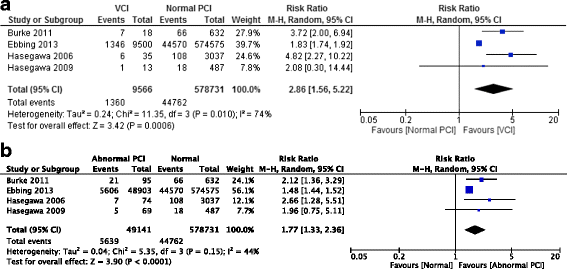Abnormal placental cord insertion and adverse pregnancy outcomes: a systematic review and meta-analysis
- PMID: 29208042
- PMCID: PMC5718132
- DOI: 10.1186/s13643-017-0641-1
Abnormal placental cord insertion and adverse pregnancy outcomes: a systematic review and meta-analysis
Abstract
Background: Abnormal placental cord insertion (PCI) includes marginal cord insertion (MCI) and velamentous cord insertion (VCI). VCI has been shown to be associated with adverse pregnancy outcomes. This systematic review and meta-analysis aims to determine the association of abnormal PCI and adverse pregnancy outcomes.
Methods: Embase, Medline, CINAHL, Scopus, Web of Science, ClinicalTrials.gov, and Cochrane Databases were searched in December 2016 (from inception to December 2016). The reference lists of eligible studies were scrutinized to identify further studies. Potentially eligible studies were reviewed by two authors independently using the following inclusion criteria: singleton pregnancies, velamentous cord insertion, marginal cord insertion, and pregnancy outcomes. Case reports and series were excluded. The methodological quality of the included studies was assessed using the Newcastle-Ottawa Scale. Outcomes for meta-analysis were dichotomous and results are presented as summary risk ratios with 95% confidence intervals.
Results: Seventeen studies were included in the systematic review, all of which were assessed as good quality. Normal PCI and MCI were grouped together as non-VCI and compared with VCI in seven studies. Four studies compared MCI, VCI, and normal PCI separately. Two other studies compared MCI with normal PCI, and VCI was excluded from their analysis. Studies in this systematic review reported an association between abnormal PCI, defined differently across studies, with preterm birth, small for gestational age (SGA), low birthweight (< 2500 g), emergency cesarean delivery, and intrauterine fetal death. Four cohort studies comparing MCI, VCI, and normal PCI separately were included in a meta-analysis resulting in a statistically significant increased risk of emergency cesarean delivery for VCI (pooled RR 2.86, 95% CI 1.56-5.22, P = 0.0006) and abnormal PCI (pooled RR 1.77, 95% CI 1.33-2.36, P < 0.0001) compared to normal PCI.
Conclusions: The available evidence suggests an association between abnormal PCI and emergency cesarean delivery. However, the number of studies with comparable definitions of abnormal PCI was small, limiting the analysis of other adverse pregnancy outcomes, and further research is required.
Keywords: Abnormal placental cord insertion; Adverse pregnancy outcomes; Emergency cesarean delivery; Marginal placental cord insertion; Small for gestational age; Velamentous placental cord insertion.
Conflict of interest statement
Ethics approval and consent to participate
Not applicable.
Consent for publication
Not applicable.
Competing interests
The authors declare that they have no competing interests.
Publisher’s Note
Springer Nature remains neutral with regard to jurisdictional claims in published maps and institutional affiliations.
Figures


Similar articles
-
Impact of velamentous cord insertion on perinatal outcomes: a systematic review and meta-analysis.Am J Obstet Gynecol MFM. 2023 Feb;5(2):100812. doi: 10.1016/j.ajogmf.2022.100812. Epub 2022 Nov 12. Am J Obstet Gynecol MFM. 2023. PMID: 36379439
-
A systematic review and meta-analysis of velamentous cord insertion among singleton pregnancies and the risk of preterm delivery.Int J Gynaecol Obstet. 2018 Jul;142(1):9-14. doi: 10.1002/ijgo.12489. Epub 2018 Apr 10. Int J Gynaecol Obstet. 2018. PMID: 29572823 Free PMC article.
-
Impact of marginal cord insertion on perinatal outcomes: a systematic review and meta-analysis.Am J Obstet Gynecol MFM. 2023 Apr;5(4):100876. doi: 10.1016/j.ajogmf.2023.100876. Epub 2023 Jan 26. Am J Obstet Gynecol MFM. 2023. PMID: 36708965
-
Placental implantation abnormalities and risk of preterm delivery: a systematic review and metaanalysis.Am J Obstet Gynecol. 2015 Oct;213(4 Suppl):S78-90. doi: 10.1016/j.ajog.2015.05.058. Am J Obstet Gynecol. 2015. PMID: 26428506
-
Multiple-micronutrient supplementation for women during pregnancy.Cochrane Database Syst Rev. 2017 Apr 13;4(4):CD004905. doi: 10.1002/14651858.CD004905.pub5. Cochrane Database Syst Rev. 2017. Update in: Cochrane Database Syst Rev. 2019 Mar 14;3:CD004905. doi: 10.1002/14651858.CD004905.pub6. PMID: 28407219 Free PMC article. Updated.
Cited by
-
[Perinatal conditions of late preterm twins versus early term twins].Zhongguo Dang Dai Er Ke Za Zhi. 2021 Mar;23(3):242-247. doi: 10.7499/j.issn.1008-8830.2011126. Zhongguo Dang Dai Er Ke Za Zhi. 2021. PMID: 33691916 Free PMC article. Chinese.
-
"The First Thousand Days" Define a Fetal/Neonatal Neurology Program.Front Pediatr. 2021 Aug 2;9:683138. doi: 10.3389/fped.2021.683138. eCollection 2021. Front Pediatr. 2021. PMID: 34408995 Free PMC article. Review.
-
Perinatal and obstetric-neonatal outcomes following frozen embryo transfer cycles with a thinner endometrium: a retrospective study.BMC Pregnancy Childbirth. 2024 Nov 12;24(1):741. doi: 10.1186/s12884-024-06946-6. BMC Pregnancy Childbirth. 2024. PMID: 39533220 Free PMC article.
-
The impact of ultrasound-based antenatal screening strategies to detect vasa praevia in the United Kingdom: An exploratory study using decision analytic modelling methods.PLoS One. 2022 Dec 20;17(12):e0279229. doi: 10.1371/journal.pone.0279229. eCollection 2022. PLoS One. 2022. PMID: 36538562 Free PMC article.
-
Vaginal delivery in a pregnant woman with cord prolapse, velamentous cord insertion, and fetal vertex presentation: A case report.Medicine (Baltimore). 2018 Nov;97(45):e13221. doi: 10.1097/MD.0000000000013221. Medicine (Baltimore). 2018. PMID: 30407364 Free PMC article.
References
-
- Baergen RN. Pathology of the Umbilical Cord, in Manual of Pathology of the Human Placenta, Second edn. New York: Springer Science & Business Media; 2011.
-
- Benirschke K. Manual of pathology of the human placental. 2. New York: Spinger Science & Business Media; 2011.
Publication types
MeSH terms
LinkOut - more resources
Full Text Sources
Other Literature Sources
Medical
Miscellaneous

